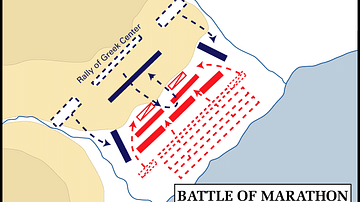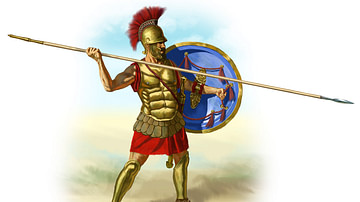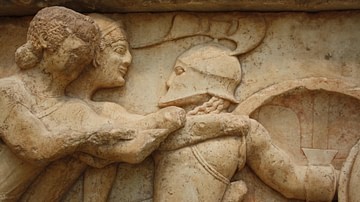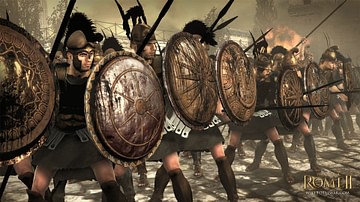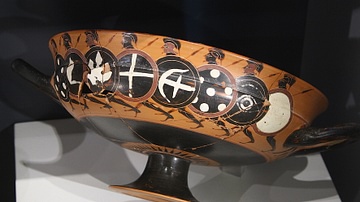
A Peltast was a type of Greek infantryman who was usually armed with a javelin and who carried a light shield. Originating from Thrace, the peltast was a common sight in Greek warfare during the Classical period and especially following the Peloponnesian War.
The name peltast derives from peltē which was the typical crescent-shaped shield this type of soldier usually carried. The military type originated in the Archaic period around Thrace, and fighting as mercenaries, these peltastes were a usual feature of several Greek city-state armies. In the Classical period the term peltast was used to refer to any soldier who carried a javelin, wore no armour, and carried a light shield.
The principal weapon of the peltast was, then, the javelin (akon). These measured from 1.25 to 2.25 metres in length and had smaller points than the heavier spear of the hoplite class of soldier. The peltast also had a shield made from wicker or hide stretched over a wooden frame which was, therefore, much lighter than the bronze-faced shield that hoplites carried. This and the lack of heavy bronze armour and helmet meant that the peltasts were much more mobile in the field than hoplites.
A well-trained peltast could perhaps throw his javelin some 25 metres or even further. To assist the throw, the peltast often used a leather thong (ankyle) which was wrapped around the shaft and looped onto the first two fingers. Released when the arm was extended in the final moments of the throw, the thong extended the leverage and reach of the hand and therefore the distance the javelin would travel. Obviously, peltasts were best employed at some distance from the enemy, and they were usually formed into groups of as many as 600, positioned on the flanks of the hoplite phalanx. Also, no doubt because of their higher mobility, peltasts were probably also used as forward scouts.
Although no match for an organised hoplite phalanx formation, the peltasts were effective against heavily-armoured opponents when they employed shoot and evade tactics. The hoplites were simply too heavily weighed down with armour to effectively pursue peltasts for a great distance. In addition, if the terrain was uneven, if the hoplites were out of formation or if attacking from the flanks or rear, then peltasts could even defeat a hoplite force. Notable victories in this manner occurred in 424 BCE when Athenian peltasts defeated Spartan hoplites on the uneven terrain of the island of Sphaktria in the Peloponnese. Another battle where peltast mobility and also their willingness to engage at close quarters when necessary won the day was at Amphipolis in 422 BCE. Here the Spartan general Brasidas employed Myrkinian and Chalkidian peltasts with devastating effect to defeat a force of Athenian hoplites. As a third example, the Athenian leader Iphikrates defeated Spartan hoplites with his peltasts in 390 BCE at Lechaion near Corinth when he employed a series of strike and run attacks. However, as peltasts were unlikely to completely defeat a force of organised hoplites on good ground, it became increasingly evident from the 4th century BCE that the most successful armies were those that employed a mix of both elements, along with other types of soldier such as archers, slingers, and eventually cavalry.
